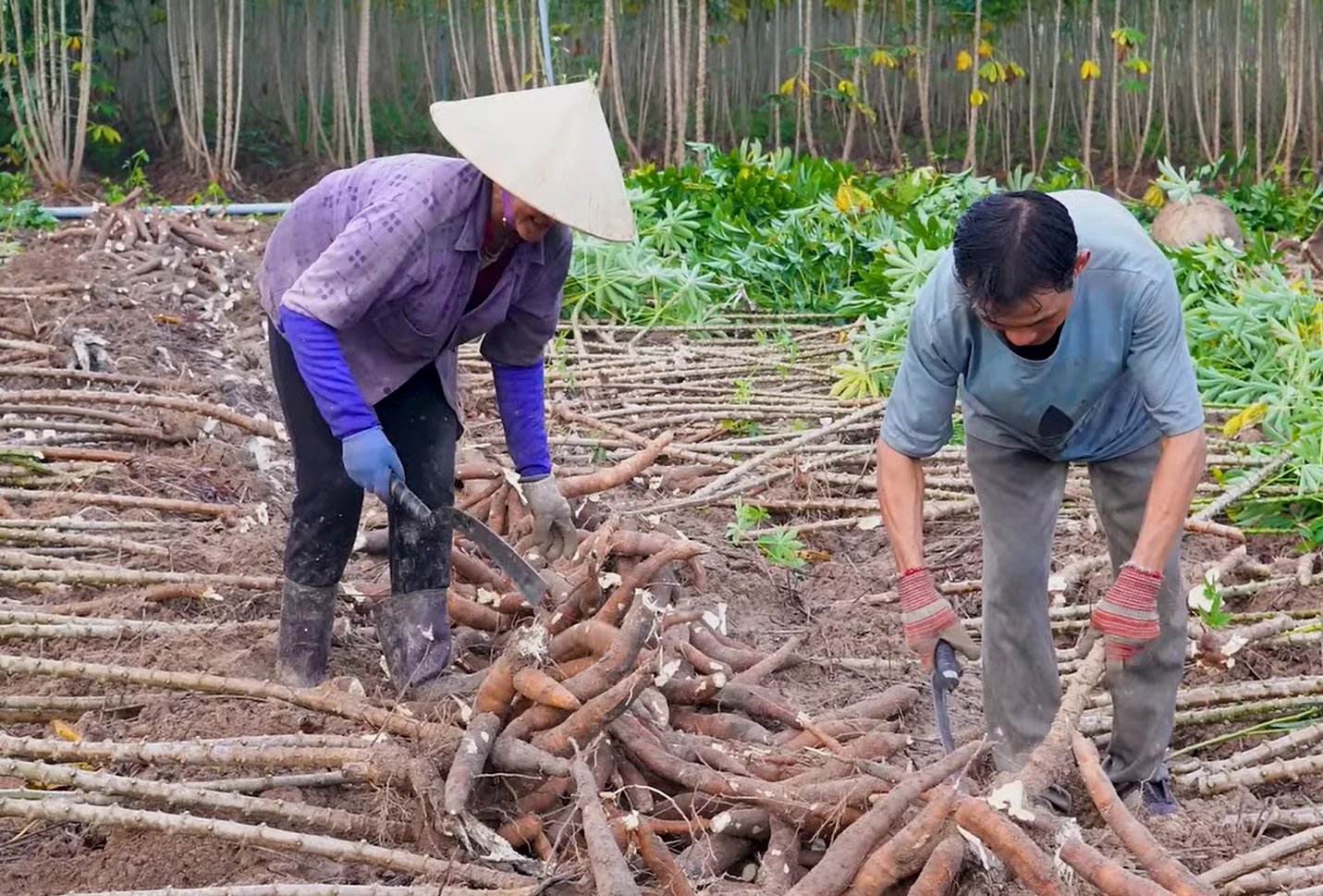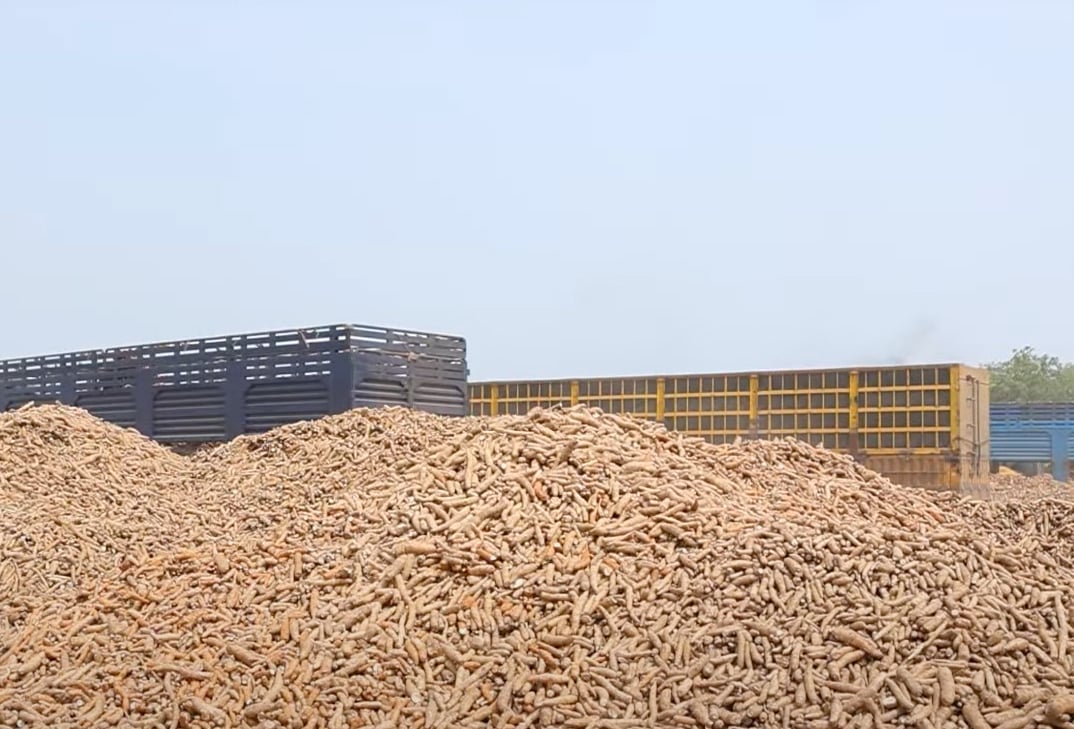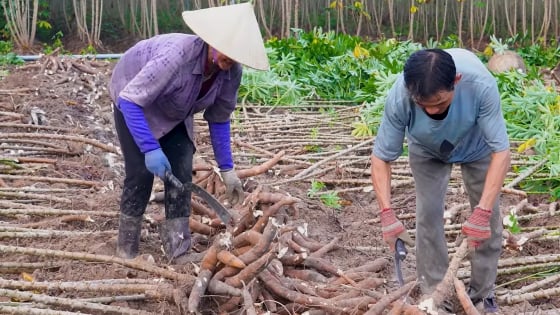(VAN) Vietnam’s cassava prices has decreased significantly since the beginning of this year due to a sharp decline in export prices. It is highly likely that the cassava prices will rise in the near future.

Cassava harvest in Duong Minh Chau district, Tay Ninh province. Photo: Son Trang.
Tay Ninh province, the second-largest cassava growing area in Vietnam, is entering the harvest season for the 2024-2025 winter-spring cassava crop. Compared to the previous winter-spring season, cassava farmers in Tay Ninh are unhappy due to the significant price drop.
Mr. Nguyen Van Vang, a farmer from Cha La commune, Duong Minh Chau district, Tay Ninh, said that in the 2023-2024 winter-spring season, if cassava reached a starch content of 30%, farmers could sell it for 110-120 dong per degree of starch (equivalent to 3.300-3.600 dong/kg). However, in April of this year, the price of cassava dropped to only around 80 dong per degree of starch (about 2.400 dong/kg). As a result, cassava prices in the 2024-2025 winter-spring season in Tay Ninh have decreased by more than 1.000 dong/kg.
Due to the sharp decline in prices, many farmers who lease land to grow cassava in Tay Ninh are at risk of making a loss. Ms. Le Thi Tam, another farmer in Cha La commune, shared that with the current price of cassava, households growing cassava on their own land, with high yields and high starch content due to the use of quality seeds and the application of advanced techniques, are still making a small profit. However, the risk of loss is very high for those leasing land to grow cassava, with rental fees reaching several tens of millions of dong per hectare.
According to the Vietnam Cassava Association, not only in Tay Ninh, but the price of cassava has also dropped sharply in all key cassava-growing provinces and regions. At the end of April, the price of cassava in bulk in the North was averaging 1.350-1.650 dong/kg, in the Central region from 1.450-1.950 dong/kg, and in Kon Tum from 1.400-1.600 dong/kg. These prices are much lower compared to May 2024, when the price of cassava in the North was 2.750-2.850 dong/kg, in the Central region 2.950-3.100 dong/kg, and in Kon Tum 2.700-3.000 dong/kg.
Fresh cassava prices in Vietnam have dropped sharply due to the decline in export prices. According to information from the Vietnam Cassava Association, by the end of April, the price of cassava starch for export at the port of Ho Chi Minh City had fallen to 375-385 USD/ton (FOB), a significant drop from 520-530 USD/ton in May 2024. At the same time, at the port of Quy Nhon, the price of dried cassava chips for export was 260 USD/ton (to South Korea) and 195 USD/ton (to China), down 55-60 USD/ton compared to May 2024. Not only Vietnam, but the price of cassava from Thailand also decreased sharply, from 565 USD/ton in early May 2024 to 415 USD/ton by the end of April.
According to the Import-Export Department (Ministry of Industry and Trade), in the first quarter of 2025, the average export price of cassava and cassava products decreased sharply compared to the same period in 2024. Specifically, the average export price of cassava starch was 360 USD/ton, down 30.2%, and the average export price of dried cassava chips was 190 USD/ton, down 25.9% compared to the same period in 2024.
The sharp decline in cassava export prices has led to a decrease in export value despite a significant increase in export volume. The Import-Export Department reported that in the first quarter of 2025, Vietnam’s cassava and cassava product exports reached 1.21 million tons, valued at 373 million USD, a 28.4% increase in volume but a 13.2% decrease in value compared to the same period in 2024.

The price of cassava may increase in the coming time. Photo: Son Trang.
However, according to some cassava traders, there are factors that could help improve the price of cassava in Vietnam. Firstly, in the animal feed market, many factories face difficulties with certain domestic ingredients, such as the high price of rice bran and the limited supply of dry cassava residue. In response, many factories are increasing their purchase of cassava chips to mix into animal feed products. Meanwhile, cassava chips in stock are running low as the 2024-2025 harvest season is nearly over. Therefore, it is predicted that both domestic and export cassava chip prices could rise in the near future.
Since cassava starch is at the end of the 2024-2025 season, many factories have already stopped production, and the remaining factories are operating at low capacity to consume the cassava available from farmers. As a result, the price of Vietnamese cassava starch could increase as supply gradually decreases. The amount of cassava starch in Vietnam is expected to meet demand until the start of the new production season in 2025-2026.
According to the Import-Export Department, in the first quarter of 2025, cassava starch, dried cassava chips, and processed cassava root were the key export products of Vietnam’s cassava industry. Among these, cassava starch was the most exported, with 834.000 tons worth 301 million USD, a 15.7% increase in volume, but a 19.2% decrease in value compared to the same period in 2024. In contrast, exports of dried cassava chips saw a significant increase compared to the same period in 2024, reaching 375.000 tons worth 71 million USD, up 69.6% in volume and 25.7% in value.
$ 1 = VND 25.957 – Source: Vietcombank.
Agriculture News | Agri Products Price



